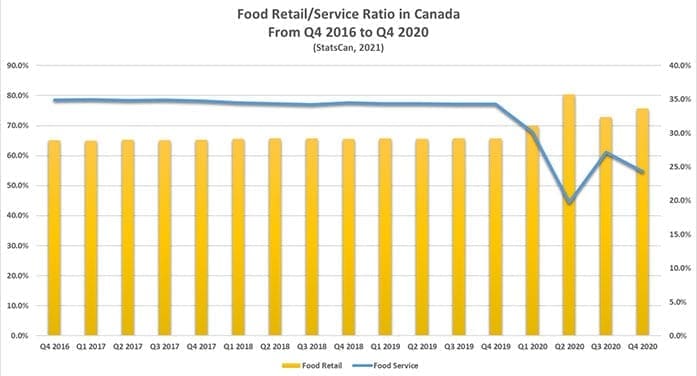 It was certainly a year to be forgotten for the food service industry. Statistics Canada numbers told us this week that food service sales dropped a whopping 32 percent from the fourth quarter of 2019 to the same period in 2020.
It was certainly a year to be forgotten for the food service industry. Statistics Canada numbers told us this week that food service sales dropped a whopping 32 percent from the fourth quarter of 2019 to the same period in 2020.
The food retail/service ratio, a key metric to assess how important food service is in our lives, also saw a significant shift in the fourth quarter of 2020. Before the pandemic, about 35 percent of all the money spent on food in Canada was in food service and restaurants. In quarter two of 2020, it went below 20 percent, the lowest level in decades.
It’s back up to 24.3 percent but that’s still a very low percentage compared to before the pandemic.
Across the country, the sector registered fewer than 20 bankruptcies since August. But many restaurants have simply closed or given up on their business. COVID-19 has ripped away the dreams of many entrepreneurs and chefs. It’s heartbreaking.
Even worse, a large number of new Canadians, who have brought more innovation and wealth into the sector over the last several years, have had to close shop. A lot of them were family businesses. It’s happening around the world, including in Canada.
But COVID-19 may offer the food service industry an opportunity to experience a great reset. Like many sectors, food service has had to adapt, pivot, convert and change over the last 12 months to survive. It has been incredible.
While the industry will come out of the pandemic with scars, the future presents a great opportunity to redefine its purpose in our overall economy.
Even with the pandemic’s end in sight, it’s unclear if people will be comfortable going out and about, patronizing their favourite restaurants again. It will take time before most Canadians stop fearing the virus. The fear must be managed carefully by restaurant operators.
While many establishments have disappeared, the gap created by the massive exodus will provide room for more innovation. New recipes, new cuisines, new ingredients, new tastes, new ways of serving, new restaurant designs and more.

Canadians, coming out of their kitchen-intensive pandemic days more food literate, will have different expectations. The need for more creativity will spark innovation for years to come. Perhaps it won’t happen at the very beginning of the post-pandemic era, when pent-up demand will get people out no matter what. But soon after, Canadians will expect more.
The way the competitive landscape is defined by operators will also change. As a result of the pandemic, the supply chain is much more open and democratized. Many companies can sell online – and not just food. Prepared meals and meal kits are being delivered at a record pace.
With e-commerce becoming a legitimate strategic option for a growing number of operations, farmers, farmers’ markets, and processors can and are selling directly to consumers.
Kraft Heinz, of all companies, is operating three ghost kitchens in Canada. Imagine, a multinational consumer goods company delivering meals to consumers. Profits aren’t the aim – rather, it’s about understanding the ever-changing customer.
Loblaws, through its PC Chef app, is in the meal kits business as well, prepared by well-established restaurants in some parts of the country.
The pandemic has altered the rules for everyone, including restauranteurs. Market access and consumers’ expectations will make things interesting. A combination of both always leads to more innovation.
On the human side of the equation, the sector will need to find a way not only to attract more talent but also to offer people a chance to build careers. Salaries and how workers are compensated need urgent attention.
During COVID-19, the no-tipping agenda was brought back into focus. Tipping is known to be discriminatory and can only benefit the few. The experience, and the meal itself, is the product of many people’s work, not just the server.
To make the sector more attractive, and for equality’s sake, the practice of including the tip in prices, like we see in many parts of the world, will need serious consideration.
It’s time for a great reset so the sector becomes a place of choice for a growing number of people who have lost their professional positions due to COVID’s wrath.
It’s unclear when Canadians will be back out in full force and once again spending at least 35 percent of their budget on food consumed outside the home. It could take a few years, perhaps more.
But as with everything, humans will bounce back – and a different food service industry will surely be ready.
Dr. Sylvain Charlebois is senior director of the agri-food analytics lab and a professor in food distribution and policy at Dalhousie University.
Sylvain is one of our contributors. For interview requests, click here.
The views, opinions and positions expressed by columnists and contributors are the author’s alone. They do not inherently or expressly reflect the views, opinions and/or positions of our publication.


